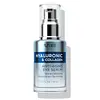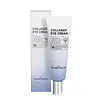What's inside
What's inside
 Key Ingredients
Key Ingredients

 Benefits
Benefits

 Concerns
Concerns

 Ingredients Side-by-side
Ingredients Side-by-side

Water
Skin ConditioningGlycerin
HumectantDipropylene Glycol
HumectantBetaine
HumectantSodium Hyaluronate
HumectantRetinol
Skin ConditioningAloe Barbadensis Leaf Extract
EmollientBeta-Glucan
Skin ConditioningMacadamia Ternifolia Seed Oil
EmollientPanthenol
Skin ConditioningNiacinamide
SmoothingButylene Glycol
HumectantCaprylic/Capric Triglyceride
MaskingHydrogenated Lecithin
EmulsifyingCholesterol
EmollientBrassica Campestris Sterols
EmollientCeteth-3
EmulsifyingCeteth-5
EmulsifyingTocopheryl Acetate
AntioxidantPotassium Cetyl Phosphate
EmulsifyingPolysorbate 20
EmulsifyingAlcohol
AntimicrobialHydroxyethylcellulose
Emulsion StabilisingArginine
MaskingCarbomer
Emulsion StabilisingPEG-60 Hydrogenated Castor Oil
EmulsifyingGlyceryl Acrylate/Acrylic Acid Copolymer
Humectant1,2-Hexanediol
Skin ConditioningEthylhexylglycerin
Skin ConditioningPhenoxyethanol
PreservativeParfum
MaskingWater, Glycerin, Dipropylene Glycol, Betaine, Sodium Hyaluronate, Retinol, Aloe Barbadensis Leaf Extract, Beta-Glucan, Macadamia Ternifolia Seed Oil, Panthenol, Niacinamide, Butylene Glycol, Caprylic/Capric Triglyceride, Hydrogenated Lecithin, Cholesterol, Brassica Campestris Sterols, Ceteth-3, Ceteth-5, Tocopheryl Acetate, Potassium Cetyl Phosphate, Polysorbate 20, Alcohol, Hydroxyethylcellulose, Arginine, Carbomer, PEG-60 Hydrogenated Castor Oil, Glyceryl Acrylate/Acrylic Acid Copolymer, 1,2-Hexanediol, Ethylhexylglycerin, Phenoxyethanol, Parfum
Hydrolyzed Collagen 44%
EmollientCyclopentasiloxane
EmollientDimethicone
EmollientCyclohexasiloxane
EmollientWater
Skin ConditioningCaprylyl Methicone
Skin ConditioningCetearyl Dimethicone
EmollientCetearyl Dimethicone Crosspolymer
Dimethicone/PEG-10/15 Crosspolymer
C30-45 Alkyl Cetearyl Dimethicone Crosspolymer
EmollientSodium Citrate
BufferingPEG-9 Polydimethylsiloxyethyl Dimethicone
EmulsifyingPEG-10 Dimethicone
Skin ConditioningFructooligosaccharides
HumectantSaccharide Hydrolysate
HumectantEthylhexylglycerin
Skin ConditioningAdenosine
Skin ConditioningLippia Citriodora Leaf Extract
AstringentTocopherol
AntioxidantIris Florentina Root Extract
MaskingCaprylic/Capric Triglyceride
MaskingBeta-Glucan
Skin ConditioningVaccinium Macrocarpon Fruit Extract
AstringentPrunus Serotina Fruit Extract
MaskingPunica Granatum Fruit Extract
AntioxidantHydrolyzed Hyaluronic Acid
HumectantSerine
MaskingThreonine
Proline
Skin ConditioningPhenoxyethanol
PreservativeParfum
MaskingHydrolyzed Collagen 44%, Cyclopentasiloxane, Dimethicone, Cyclohexasiloxane, Water, Caprylyl Methicone, Cetearyl Dimethicone, Cetearyl Dimethicone Crosspolymer, Dimethicone/PEG-10/15 Crosspolymer, C30-45 Alkyl Cetearyl Dimethicone Crosspolymer, Sodium Citrate, PEG-9 Polydimethylsiloxyethyl Dimethicone, PEG-10 Dimethicone, Fructooligosaccharides, Saccharide Hydrolysate, Ethylhexylglycerin, Adenosine, Lippia Citriodora Leaf Extract, Tocopherol, Iris Florentina Root Extract, Caprylic/Capric Triglyceride, Beta-Glucan, Vaccinium Macrocarpon Fruit Extract, Prunus Serotina Fruit Extract, Punica Granatum Fruit Extract, Hydrolyzed Hyaluronic Acid, Serine, Threonine, Proline, Phenoxyethanol, Parfum
Ingredients Explained
These ingredients are found in both products.
Ingredients higher up in an ingredient list are typically present in a larger amount.
Beta-Glucan is a polysaccharide. It can be derived from the cell walls of seaweed, oats, yeast, and fungi. It hydrates the skin and helps boost your skin's natural barrier.
As an antioxidant, beta-glucan helps fight free-radicals. Free-radicals are molecules that may damage your skin cells, such as pollution.
Studies show this ingredient may be an effective wrinkle reducer as it can deeply penetrate into skin. It has also been show to help with wound healing.
Learn more about Beta-GlucanThis ingredient is an emollient, solvent, and texture enhancer. It is considered a skin-softener by helping the skin prevent moisture loss.
It helps thicken a product's formula and makes it easier to spread by dissolving clumping compounds.
Caprylic Triglyceride is made by combining glycerin with coconut oil, forming a clear liquid.
While there is an assumption Caprylic Triglyceride can clog pores due to it being derived from coconut oil, there is no research supporting this.
Learn more about Caprylic/Capric TriglycerideEthylhexylglycerin (we can't pronounce this either) is commonly used as a preservative and skin softener. It is derived from glyceryl.
You might see Ethylhexylglycerin often paired with other preservatives such as phenoxyethanol. Ethylhexylglycerin has been found to increase the effectiveness of these other preservatives.
Parfum is a catch-all term for an ingredient or more that is used to give a scent to products.
Also called "fragrance", this ingredient can be a blend of hundreds of chemicals or plant oils. This means every product with "fragrance" or "parfum" in the ingredients list is a different mixture.
For instance, Habanolide is a proprietary trade name for a specific aroma chemical. When used as a fragrance ingredient in cosmetics, most aroma chemicals fall under the broad labeling category of “FRAGRANCE” or “PARFUM” according to EU and US regulations.
The term 'parfum' or 'fragrance' is not regulated in many countries. In many cases, it is up to the brand to define this term.
For instance, many brands choose to label themselves as "fragrance-free" because they are not using synthetic fragrances. However, their products may still contain ingredients such as essential oils that are considered a fragrance by INCI standards.
One example is Calendula flower extract. Calendula is an essential oil that still imparts a scent or 'fragrance'.
Depending on the blend, the ingredients in the mixture can cause allergies and sensitivities on the skin. Some ingredients that are known EU allergens include linalool and citronellol.
Parfum can also be used to mask or cover an unpleasant scent.
The bottom line is: not all fragrances/parfum/ingredients are created equally. If you are worried about fragrances, we recommend taking a closer look at an ingredient. And of course, we always recommend speaking with a professional.
Learn more about ParfumPhenoxyethanol is a preservative that has germicide, antimicrobial, and aromatic properties. Studies show that phenoxyethanol can prevent microbial growth. By itself, it has a scent that is similar to that of a rose.
It's often used in formulations along with Caprylyl Glycol to preserve the shelf life of products.
Water. It's the most common cosmetic ingredient of all. You'll usually see it at the top of ingredient lists, meaning that it makes up the largest part of the product.
So why is it so popular? Water most often acts as a solvent - this means that it helps dissolve other ingredients into the formulation.
You'll also recognize water as that liquid we all need to stay alive. If you see this, drink a glass of water. Stay hydrated!
Learn more about Water